|
|
|
|
Analytic geometry
- Conic sections
|
|
|
|
::
Intersection of ellipse and line - tangency condition
|
|
Common points of a line and an ellipse
we find by solving their equations as a system of two equations in two
unknowns, x
and y, |
|
(1) y = mx + c
by plugging (1)
into (2)
=>
b2x2
+ a2(mx + c)2 = a2b2 |
|
(2) b2x2 + a2y2
= a2b2
and
after
rearranging (a2m2
+ b2)·x2 + 2a2mc·x
+ a2c2 -
a2b2 = 0 |
| obtained
is the quadratic equation in x.
Thus, the coordinate of intersections are, |
 |
| Using the above solutions follows that a line and an ellipse can have one of three possible mutual positions
depending of the value of the discriminant
D
= a2m2
+ b2 -
c2. Thus, if |
|
D > 0,
a line and an ellipse
intersect, and if D < 0,
a line and an ellipse
do not intersect, |
|
while
if
D = 0,
or a2m2
+ b2 = c2
a line is the tangent to the
ellipse thus, it is the tangency
condition.
|
|
The line touches the ellipse at the tangency point whose coordinates are: |
 |
|
|
Equation of the tangent at a point on the ellipse
|
|
In the equation
of the line y
-
y1 = m(x
-
x1)
through a given point P1, the slope m
can be determined using known coordinates (x1,
y1) of the point of tangency, so
|
 |
|
b2x1x
+ a2y1y
= b2x12
+ a2y12,
since b2x12
+ a2y12 =
a2b2
is the condition that P1
lies on the ellipse
|
|
then
b2x1x
+ a2y1y
= a2b2
is the
equation of the tangent at the point P1(x1,
y1)
on the ellipse.
|
|
|
Construction of the tangent at a point on the ellipse
|
|
Draw a circle of a radius
a concentric to the ellipse. Extend the ordinate of the given point to find
|
|
intersection with the circle. The tangent of the circle at
Pc
intersects the x-axis at
Px. The tangent to the ellipse at the point P1
on the
ellipse intersects the x-axis at the same point.
|
|
To prove this, find the
x-intercept of each tangent
analytically.
|
|
Therefore, in both equations of tangents set y = 0 and
solve for x,
|
 |
| it is the x-intercept of the tangent
tc
and the tangent te.
|
|
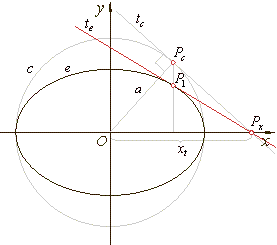 |
|
|
|
Angle between the focal radii at a point of the ellipse
|
|
Let
prove that the tangent at a point
P1
of the ellipse is perpendicular to the bisector of the angle between the focal radii
r1
and r2.
Coordinates of points,
F1(-c,
0),
F2(c,
0) and P1(x1,
y1) plugged
into
|
|
|
|
By plugging the slopes of these tree lines into the formula for calculating the angle between lines we find the
exterior angles
j1
and j2
subtended by these lines at P1. |
|
Thus, using the condition
b2x12
+ a2y12
= a2b2, that the point lies on the ellipse, obtained is |
 |
|
Therefore, the normal at the point
P1
of the ellipse bisects the interior angle between its focal radii.
|
|
|
Example:
Find a point on the ellipse
x2
+ 5y2 = 36 which is the closest, and which is the farthest from the
line 6x + 5y - 25 =
0.
|
|
|
|
Tangents to an ellipse from a
point outside the ellipse - use of the tangency condition
|
|
Coordinates of the point
A(x, y), from which we draw tangents to an ellipse, must satisfy
equations of the tangents, y
= mx + c and their slopes and intercepts,
m and
c, must satisfy the
condition of tangency therefore, using the system of equations, |
| (1)
y = mx + c
<=
A(x, y) |
|
(2)
a2m2 + b2
= c2
determined are equations of the tangents from a point A(x, y)
outside the ellipse.
|
|
|
Construction of tangents from a point outside the ellipse
|
|
With
A
as center, draw an arc through F2, and from
F1
as center, draw an arc of the radius 2a. Tangents are
then the perpendicular bisectors of the line segments,
F2S1 and
F2S2.
|
|
We can also draw tangents as lines through A
and the intersection points of the segments F1S1 and
F1S2
and the ellipse. |
|
Thus, these intersections are the tangency points
of the tangents to the ellipse. |
| Explanation of the construction lies at the fact that, |
| F1S1 =
F1D1 +
D1S1 =
F1D1 +
D1F2 = 2a
|
| according to the definition of the ellipse, as well as
the point A
is equidistant from points F2 and
S1,
since the point S1
lies on the arc drawn from A
through F2.
|
|
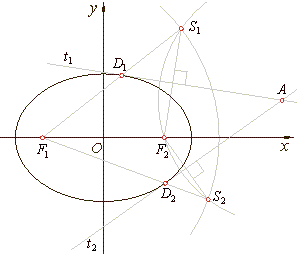 |
|
|
|
Example:
Determine equation of the ellipse which the line
-3x +
10y = 25 touches at the point
P(-3,
8/5).
|
|
Solution: As the given line is the tangent to the ellipse,
parameters, m
and c
of the line must satisfy the tangency condition, and the point P
must satisfy the equations of the line and the ellipse, thus |
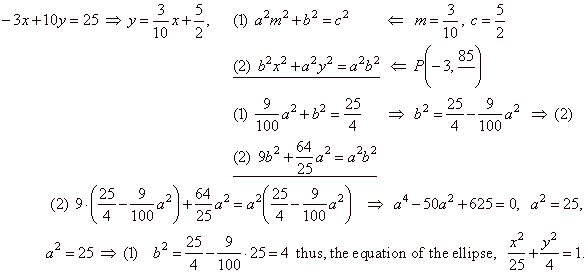 |
|
|
Example:
Find the equations of the common tangents of the curves
4x2
+ 9y2 = 36 and
x2
+ y2 = 5.
|
|
Solution: The common tangents of the ellipse and the circle
must satisfy the tangency conditions of these curves, thus
|
|
|
 |
|
|
Polar and pole of the ellipse
|
|
If from a point A(x0, y0), exterior to the ellipse, drawn are tangents, then the secant line passing through the
contact points, D1(x1, y1) and
D2(x2, y2) is the polar of the point
A. The point
A is called the
pole of |
| the
polar,
as shows the right figure. |
|
Coordinates of the point
A(x0, y0) must satisfy the equations of tangents, thus |
| t1 ::
b2x0x1
+ a2y0y1
= a2b2 |
| t2 ::
b2x0x2
+ a2y0y2
= a2b2 |
| and after
subtracting
t1
-
t2 |
| b2x0(x2
-
x1)
+ a2y0(y2
-
y1)
= 0
|
| obtained
is |
 |
|
|
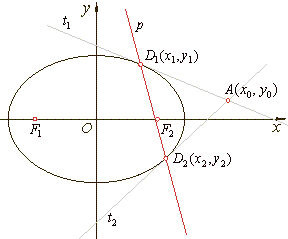 |
|
|
the slope of the secant line through points of contact
D1and
D2.
|
|
Thus, the equation of the secant line
|
 |
and after rearranging |
|
| b2x0x
+ a2y0y
= b2x0x1
+ a2y0y1,
since b2x0x1
+ a2y0y1
= a2b2 |
| follows
b2x0x
+ a2y0y
= a2b2
the equation of
the polar p
of the
point A(x0, y0). |
|
|
Example:
The line x
+ 14y
-
25 = 0 is the polar of the ellipse
x2
+ 4y2 = 25.
Find coordinates of the pole.
|
|
Solution: Intersections of the polar and the ellipse are points
of contact of tangents drawn from the pole P
to ellipse, thus solutions of the system of equations, |
| (1)
x
+ 14y
-
25 = 0 => x
= 25 - 14y
=> (2) |
| (2)
x2
+ 4y2 = 25
|
| (25 - 14y)2
+ 4y2 = 25
|
| 2y2
-
7y + 6 = 0,
y1 =
3/2 and
y2 =
2
|
| y1
and y2
=>
x
= 25 - 14y,
x1 =
4 and
x2 =
-3.
|
| Thus, the points of
contact D1(4,
3/2) and
D2(-3,
2).
|
| The
equations of the tangents at D1
and
D2,
|
|
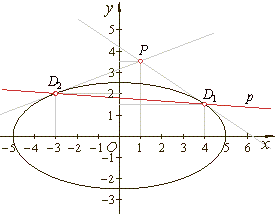 |
|
 |
|
The solutions of the system of equations t1
and t2
are the coordinates of the
pole P(1, 7/2). |
|
|
|
|
|
|
|
|
|
|
|
|
|
|
|
|
|
|
|
|
|
|
|
|
|
|
|
|
Contents C
|
|
|
|
|

|
|
|
|
|
|
Copyright
© 2004 - 2020, Nabla Ltd. All rights reserved.
|
|
|